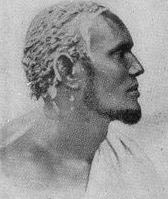 | ||
The Madhiban (Somali: Madhibaan), also known as Midgan, Midgaan, Mitjan, Muse Dheri or Gaboye, are an artisanal caste among Somali people. They have been endogamous, and their traditional hereditary occupation has been as hunters and circumcision performers.
Contents
- Distribution and names
- Discussion
- Description from 1890
- Law
- Cognate castes in Horn of Africa
- Notable Madhiban
- References
They are also referred to as Madhibe, an appellation which is sometimes used pejoratively. The Madhiban have been one of the low status castes among the Somalis, along with Tumal and others.
Distribution and names
The Madhiban are a part of the Somali ethnic group found in the Horn of Africa region, particularly in modern Somalia, Ethiopia, northeastern Kenya, Djibouti and Eritrea.
According to a 1960 count, they numbered around 20,000 out of 640,000 Somalis in parts of Somalia that were within the then British Protectorate. Their numbers in other parts of Somalia and other Somali regions were unknown.
The terms Madhiban, Muse Dheri, Midgan or Midgaan for this Somali caste are found in historic literature, but in modern discourse, the term Gaboye is increasingly common. This caste is distinct from the Tumal and Yibir outcast communities because each is accused of things different from each other in Somali society.
Discussion
The Madhiban were historically hunters, but now engage in occupations like leather work (shoemaking). They also are the traditional circumcision performers for both males, and females in the Somali society. These professions have traditionally been considered dirty, and the Madhiban have been a part of the sab or lower castes as opposed to the aji or upper castes.
According to Lee Gunderson, Dennis Murphy Odo and Reginald D'Silva, the Midgan have traditionally been treated as a low caste, scorned and reviled. A Midgan-Madiban has been deemed as polluting and therefore avoided as a taboo in the Somali society.
Under Somalia's military administration, some Madhiban were appointed to positions within the government to promote integration. As Hawiye, the Madhiban along with the Habargidir and Abgaal (collectively referred to as Haw) have since obtained wider political representation. Their general social status has also improved with the expansion of urban centers.
Description from 1890
In 1890 Élisée Reclus, in his extensive work "The Earth and its Inhabitants: AFRICA" (Vol. IV, South and East Africa) described the Madhiban (Midgan) as follows: In still greater contempt are held the Midgans, called also Rami, that is to say "Archers," who are universally regarded as the lowest of the low. They worship trees and snakes, and eat all the prohibited food, such as fish, fowl, eggs, hares, and gazelles. They are also daring hunters, fearlessly attacking the lion and the elephant, whom they pierce with their poisoned arrows. Like the Yebirs, the Midgans also practise medicine, and have the reputation of being extremely clever charlatans. According to the Somali legends, the lower castes are the issue of crossings between Abyssinian women and maleficent genii, while the Midgans are of still more degraded origin, their ancestors having been the slaves of these Abyssinian women.
Law
Under the 1951 UN convention, several legal proceedings have ruled that Midgan as a low caste in Somalia are "akin to Dalits or the untouchables in India".
Cognate castes in Horn of Africa
The Madhiban caste is not an exception limited to the Somali ethnic group, and equivalent cognate caste is found in numerous ethnic groups in Horn of Africa and East Africa. According to Donald Levine – a professor of Sociology specializing in Ethiopian and Horn of Africa studies, similar caste groups in different languages and ethnic groups have been integral part of societies of this region. These strata have featured all the defining characteristics of caste, states Levine, characteristics such as "endogamy, hierarchy, status, concepts of pollution, restraints on commensality, a traditional occupation and membership by birth". In east African ethnic groups, such as the Oromo people, cognates to Somali castes have been recorded in 16th century texts, states Cornelius Jaenen. The table below illustrate some alternate terms for castes mirroring the Madhiban in other ethnic groups that share this region with the Somali people.
